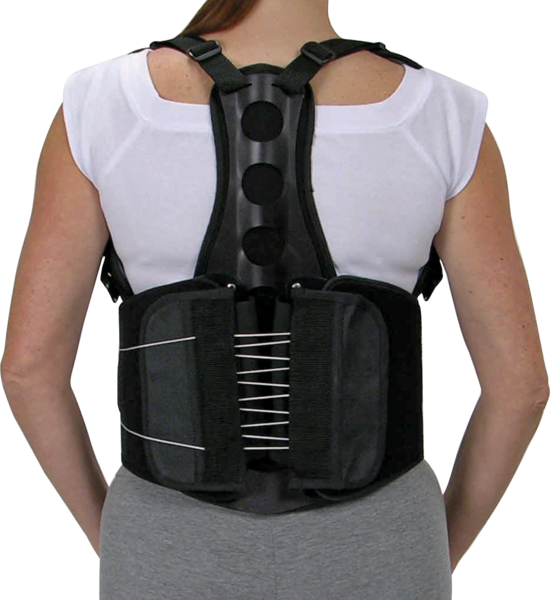Spinal health is the foundation of posture, balance, and mobility. When the spine is injured, weakened, or misaligned, it can affect daily activities and quality of life. To restore support and stability, doctors often prescribe spinal orthoses—commonly called spinal braces or spinal support devices.
These orthotic devices for the spine reduce pain, stabilize movement, and help in recovery from injuries, surgeries, or chronic spinal conditions. If you or a loved one has been recommended a spine stabilizer or back orthotic, this guide will give you a clear overview of what to expect.
What Are Spinal Orthotics?
Spinal orthotics are specialized medical devices designed to support, align, prevent, or correct deformities of the spine. They can be:
- Rigid – for strict spinal immobilization.
- Semi-rigid – for controlled support.
- Flexible – for posture correction and mild stability.
These spinal support devices are prescribed by orthopedic specialists, neurosurgeons, or rehabilitation experts. Depending on your condition, a spinal brace may be used short-term (after surgery or trauma) or long-term (for scoliosis, spinal deformities, or chronic pain).
What Are Spinal Braces Used For?
Doctors recommend spinal braces for many reasons. The most common include:
- Spinal Immobilization – Restricting movement after spinal surgery or trauma.
- Pain Relief – Acting as a pain relief orthotic device by reducing strain on muscles and vertebrae.
- Correction – Helping with conditions like scoliosis or kyphosis through a posture correction brace.
- Postural Support – Improving body alignment in people with weak back muscles.
- Stabilization – Acting as a spine alignment device to maintain proper spinal posture.
- Injury Prevention – Preventing further damage during recovery or rehabilitation.
How Do Spinal Orthoses Work?
Spinal orthoses work through three main mechanisms:
- Restriction of Motion – Limiting flexion, extension, and rotation to prevent further injury.
- Load Transfer – Shifting stress away from the injured vertebrae onto the orthopedic back support device.
- Spine Alignment – Correcting or preventing worsening of abnormal curves.
In addition, braces provide muscle support, reduce pressure on nerves, and act as rehabilitation orthotics during recovery.
Conditions That Require Spinal Orthotics
A doctor may prescribe a spinal brace for:
- Spinal fractures or trauma (compression fractures, whiplash)
- Post-surgical recovery (fusion, discectomy, laminectomy)
- Scoliosis or kyphosis correction
- Spondylolisthesis (slipped vertebra)
- Degenerative disc disease
- Osteoporosis with vertebral fractures
- Chronic lower back pain
- Spinal tumors requiring stabilization
- Weak musculature and poor posture
Types of Spinal Braces
Spinal orthoses are categorized by the area of the spine they support:
1. Cervical Orthoses (Neck Braces)
- Soft Collar – Mild support for whiplash or neck strain.
- Rigid Collar (e.g., Philadelphia Collar, Miami J) – Used for serious neck injuries or post-surgery care.
2. Thoracic Orthoses
- TLSO (Thoraco-Lumbo-Sacral Orthosis) – Covers chest to pelvis; used for scoliosis, fractures, or post-surgery stabilization.
- CTO (Cervico-Thoracic Orthosis) – Extends from chin to upper chest, supporting both neck and upper back.
3. Lumbar Orthoses (Lower Back Braces)
- Rigid Lumbar Brace – Provides strong stabilization after spinal surgery.
- Flexible Lumbar Belt – A back orthotic used for chronic low back pain or mild instability.
4. Specialty Braces
- Scoliosis Braces (Boston Brace, Milwaukee Brace, Charleston Bending Brace) – Used in children/adolescents to prevent curve progression.
- Hyperextension Brace (Jewett Brace) – Prevents forward bending after compression fractures.
- Knight–Taylor Brace – Provides thoraco-lumbar stabilization.
Potential Risks and Complications
While spinal braces are highly effective, prolonged or improper use may cause:
- Skin irritation and pressure sores.
- Muscle weakness due to reduced activity.
- Breathing restrictions (especially with rigid TLSO).
- Reduced spinal mobility or stiffness.
- Psychological discomfort or social anxiety (common in adolescents).
- Poor fit issues leading to discomfort and reduced effectiveness.
Tip: Always have regular follow-ups with your doctor or orthotist to ensure the brace fits correctly and is adjusted as your condition improves.
Key Takeaways
- Spinal orthoses (braces) are essential orthotic devices for the spine that support recovery, correct posture, and stabilize spinal alignment.
- They are used for trauma, post-surgical care, scoliosis, chronic pain, and degenerative conditions.
- Options range from simple posture correction braces to specialized spinal immobilization devices.
- Side effects can occur if braces are used incorrectly—professional supervision is always necessary.
A well-fitted spinal support device can be life-changing, allowing patients to regain independence, reduce pain, and protect their spinal health.
Conclusion
Spinal orthotics, whether used for injury recovery, posture correction, or chronic conditions, play a vital role in maintaining spinal health and overall mobility. These spinal support devices not only reduce pain but also stabilize the spine, prevent further injury, and improve quality of life. Each patient’s needs are unique, and a proper evaluation by a healthcare professional is essential before using any orthotic device for the spine.
When combined with medical care, physical therapy, and healthy lifestyle choices, the right spine stabilizer or back orthotic can make a significant difference in rehabilitation and long-term spinal health. Always consult your doctor or orthotist for the best type of spinal brace suited to your condition, and use it as part of a comprehensive care plan.

 Download Catalogue
Download Catalogue


